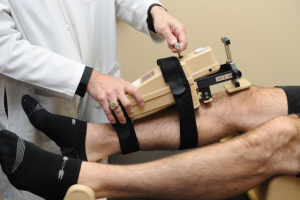The KT-1000 test is performed to provide an objective assessment of the amount of increased anterior knee translation between 20 and 30 degrees of knee flexion. The KT-1000 test was developed by Dale Daniel, MD, in San Diego, in the 1980s to provide a better objective assessment of both the diagnosis of an ACL tear and also how well ones ACL reconstruction graft heals after surgery. Through extensive testing, the investigators were able to demonstrate that intact or partial ACL tears have less than 3 mm of increased anterior translation on the KT-1000 test, while all patients with an ACL tear had 3 mm or more if increased translation, compared to the normal contralateral knee.
In addition to helping diagnose an ACL tear, the KT-1000 test can also be useful to determine the results of one’s ACL reconstruction. In general, we strive to have side-to-side differences compared to the opposite normal knee of 3 mm or less. However, in some patients, especially those who are lacking the posterior horn of their medial meniscus, the increase in side-to-side difference may be up to 5 mm. Thus, we generally believe that in patients who have 5 mm, or more, of increased anterior knee translation on the KT-1000 test, that their ACL graft is either torn or stretched out to the point where it is no longer functional.
This, we often use the KT-1000 test when it is difficult to determine if a patient truly has a torn ACL graft or not. This allows us to have a more objective assessment of a patient’s potential instability than solely relying on the physical exam to make this diagnosis.

